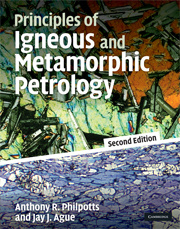Book contents
- Frontmatter
- Contents
- Preface
- Acknowledgments
- List of units
- 1 Introduction
- 2 Physical properties of magma
- 3 Intrusion of magma
- 4 Forms of igneous bodies
- 5 Cooling of igneous bodies and other diffusion processes
- 6 Classification of igneous rocks
- 7 Introduction to thermodynamics
- 8 Free energy and phase equilibria
- 9 Thermodynamics of solutions
- 10 Phase equilibria in igneous systems
- 11 Effects of volatiles on melt equilibria
- 12 Crystal growth
- 13 Isotope geochemistry related to petrology
- 14 Magmatic processes
- 15 Igneous rock associations
- 16 Metamorphism and metamorphic facies
- 17 Deformation and textures of metamorphic rocks
- 18 Graphical analysis of metamorphic mineral assemblages
- 19 Geothermometry, geobarometry, and mineral reactions among solid solutions
- 20 Mineral reactions involving H2O and CO2
- 21 Material transport during metamorphism
- 22 Pressure–temperature–time paths and heat transfer during metamorphism
- 23 Origin of rocks
- Answers to selected numerical problems
- References
- Index
21 - Material transport during metamorphism
- Frontmatter
- Contents
- Preface
- Acknowledgments
- List of units
- 1 Introduction
- 2 Physical properties of magma
- 3 Intrusion of magma
- 4 Forms of igneous bodies
- 5 Cooling of igneous bodies and other diffusion processes
- 6 Classification of igneous rocks
- 7 Introduction to thermodynamics
- 8 Free energy and phase equilibria
- 9 Thermodynamics of solutions
- 10 Phase equilibria in igneous systems
- 11 Effects of volatiles on melt equilibria
- 12 Crystal growth
- 13 Isotope geochemistry related to petrology
- 14 Magmatic processes
- 15 Igneous rock associations
- 16 Metamorphism and metamorphic facies
- 17 Deformation and textures of metamorphic rocks
- 18 Graphical analysis of metamorphic mineral assemblages
- 19 Geothermometry, geobarometry, and mineral reactions among solid solutions
- 20 Mineral reactions involving H2O and CO2
- 21 Material transport during metamorphism
- 22 Pressure–temperature–time paths and heat transfer during metamorphism
- 23 Origin of rocks
- Answers to selected numerical problems
- References
- Index
Summary
INTRODUCTION
Approximately 5 wt% H2O must be driven from a shale to convert it to a high-grade metapelitic rock. Conversely, several wt% H2O must be added to an anhydrous basalt to convert it to a chlorite schist. Clearly, metamorphism in these cases must involve the transport of considerable quantities of H2O. Similarly, CO2 released by decarbonation reactions must also be transported away from the rock. At the temperatures and pressures normally extant during metamorphism, H2O forms a supercritical fluid, which has a density similar to that of water at room temperature and pressure. The fluid has a low viscosity, and can therefore flow through fractures or an interconnected pore network. This hot fluid, in equilibrium with a rock, is certainly not pure H2O but, instead, contains considerable amounts of dissolved ions. The loss or addition of such a fluid phase during metamorphism can therefore change the bulk composition of a rock in ways other than simply modifying its content of H2O and other volatiles.
When a metamorphic rock undergoes significant changes in composition, the process of change is referred to as metasomatism. In extreme cases, metasomatism can completely change the composition of a rock, as, for example, in the conversion of limestone to magnetite ore bodies at contacts with igneous intrusions. Despite clear evidence for such major compositional changes, metasomatism was the subject of much controversy during the first half of the twentieth century.
- Type
- Chapter
- Information
- Principles of Igneous and Metamorphic Petrology , pp. 511 - 559Publisher: Cambridge University PressPrint publication year: 2009



